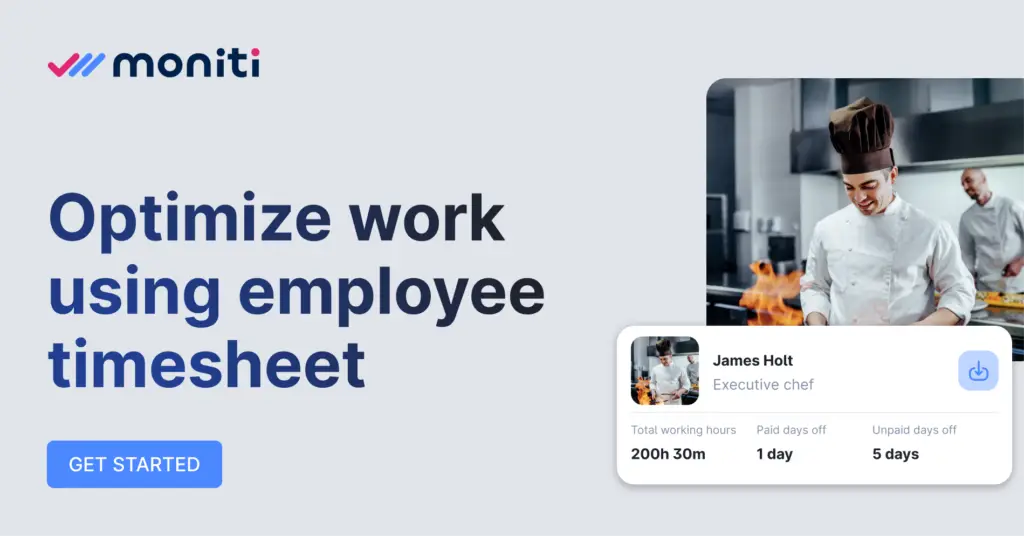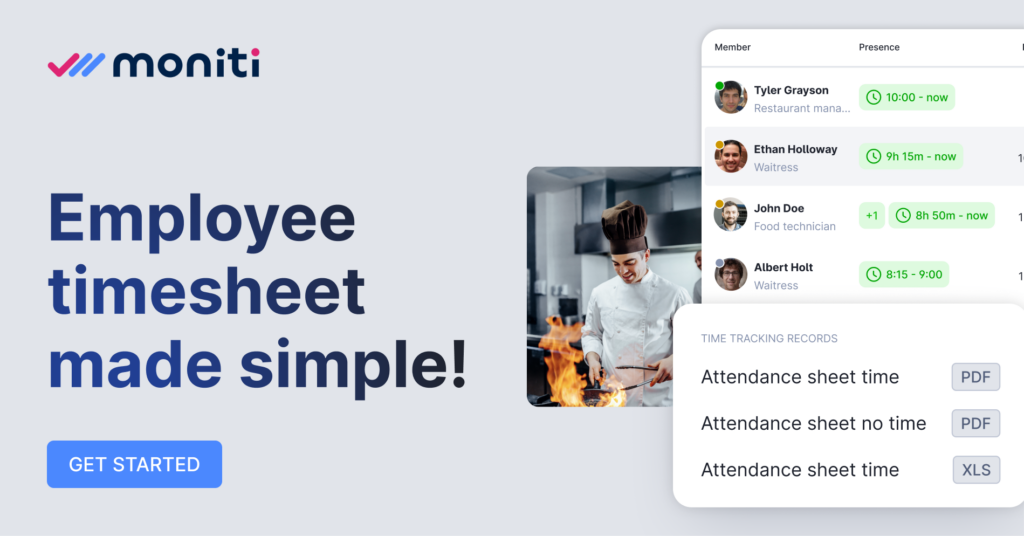Table of Contents
How can tools like timesheets and task delegation help optimize your restaurant menu?
A restaurant’s menu is more than just a list of dishes; it’s the backbone of the entire operation. An optimized menu strikes a delicate balance between variety and efficiency, ensuring customer satisfaction while keeping costs manageable and operations smooth. However, achieving this balance can be challenging. Offering too many options can overwhelm your kitchen and lead to inefficiencies, while a lack of variety might deter potential customers.
This is where modern tools like employee timesheets and task delegation systems come into play. By tracking time spent on tasks and delegating responsibilities effectively, restaurant owners and managers can streamline kitchen operations, reduce waste, and create a menu that is both enticing and manageable. Here’s how you can leverage these tools to optimize your menu and improve your overall business performance.
1. Evaluate Your current menu performance
Before making changes, it’s essential to understand how your existing menu is performing. Start by analyzing:
- Best-Selling Dishes: Identify which menu items consistently perform well.
- Low-Performing Items: Highlight dishes that rarely get ordered and assess whether they’re worth keeping.
- Profit Margins: Determine which items provide the best balance of popularity and profitability.
Using online timesheets, you can track how much time is spent preparing each dish. This helps you identify items that are labor-intensive or create bottlenecks in the kitchen. Armed with this data, you can decide which dishes to keep, modify, or remove.
2. Streamline Menu Options
One of the easiest ways to balance variety and efficiency is by simplifying your menu. Here’s how task delegation and timesheet tools can help:
- Track Preparation Times: Use online timesheets to determine how long each dish takes to prepare. Focus on dishes that are quick to make but still popular with customers.
- Consolidate Ingredients: Streamline inventory by selecting dishes that use overlapping ingredients, reducing complexity and waste.
- Eliminate Redundancy: Remove items that are too similar to others on the menu but don’t add significant value.
A streamlined menu not only reduces stress on your kitchen staff but also creates a more focused and enjoyable experience for your customers.
If you want to find out more, you should also read this article How to optimize ROI with accurate time tracking?
3. Introduce seasonal and rotational items
Adding seasonal or rotational dishes can provide variety without overwhelming your team. Online timesheets and task delegation tools can ensure these items are managed efficiently:
- Track Seasonal Prep Work: Use timesheets to monitor how much extra time is spent on new or seasonal items.
- Delegate Seasonal Tasks: Assign specific tasks—such as sourcing seasonal ingredients or creating new recipes—to team members using a task delegation app.
- Monitor Customer Feedback: Use data and feedback to determine which seasonal items are worth repeating.
This approach keeps your menu fresh and exciting without burdening your team with an unmanageable workload.
4. Improve kitchen efficiency with task delegation
A well-optimized menu depends on a highly efficient kitchen. Task delegation tools can help:
- Assign Roles Clearly: Ensure every team member knows their specific responsibilities for each shift, reducing confusion and delays.
- Streamline Prep Work: Break down complex dishes into smaller tasks and assign them to appropriate staff.
- Automate Repetitive Tasks: Use task delegation software to automate scheduling, order tracking, or inventory updates.
When your kitchen operates like a well-oiled machine, it’s easier to manage even a varied and dynamic menu.
5. Monitor and adapt with real-time data
The key to long-term menu optimization is staying adaptable. Online timesheets and task delegation apps provide real-time insights that help you make informed decisions:
- Track Trends: Use data from online timesheets to identify shifts in customer preferences or changes in kitchen efficiency.
- Evaluate New Additions: Monitor how new dishes impact prep times, inventory use, and overall workflow.
- Adjust on the Fly: Quickly reassign tasks or modify schedules based on real-time data, ensuring smooth operations even during peak hours.
By leveraging real-time data, you can continuously refine your menu to meet both customer demands and operational needs.
6. Enhance staff training
and development
Introducing a new menu or modifying an existing one often requires retraining your team. Task delegation tools can simplify this process:
- Create Training Modules: Assign specific training tasks to team members for new recipes or techniques.
- Track Progress: Use online timesheets to monitor how long it takes staff to master new skills or dishes.
- Provide Feedback: Offer constructive feedback based on performance data, helping staff improve over time.
Well-trained staff are more confident and efficient, ensuring your menu changes are implemented smoothly.
7. Reduce waste and maximize profitability
A carefully curated menu minimizes waste, which directly impacts your bottom line. Use timesheets and task delegation tools to:
- Track Ingredient Usage: Monitor how much time and effort go into prepping ingredients and identify areas for improvement.
- Optimize Inventory: Delegate inventory management tasks to ensure stock levels match menu requirements.
- Reduce Over-Ordering: Use historical data to predict ingredient needs accurately, avoiding unnecessary waste.
By aligning your menu with efficient ingredient use, you can save money and reduce your environmental footprint.
8. Simplify customer choices
A well-optimized menu isn’t just about efficiency—it’s also about creating a better customer experience. A shorter, more focused menu:
- Reduces Decision Fatigue: Customers are more likely to order quickly and confidently.
- Highlights Signature Dishes: A smaller menu emphasizes your best and most profitable items.
- Speeds Up Service: Streamlined kitchen operations mean faster order preparation and delivery.
Task delegation tools ensure your team is prepared to handle these benefits seamlessly, delivering a consistently high-quality experience.
Moniti as Your
efficiency ally
Optimizing a restaurant menu goes beyond culinary creativity—it requires effective tools to ensure smooth operations and satisfied customers. Employee timesheets and task delegation, once considered basic tools, have become essential for managing modern food service environments.
Moniti.app stands out as a comprehensive solution that integrates task scheduling and real-time tracking into one platform. By using tools like Moniti, you can track employee hours, streamline task delegation, and optimize kitchen workflows, ensuring that every resource is used efficiently and every shift operates seamlessly.
Implementing Moniti not only improves efficiency but also helps create a well-structured, forward-thinking strategy for food service management. Whether managing a traditional restaurant or a fast-paced ghost kitchen, leveraging these tools can make all the difference in achieving balance and boosting performance.





